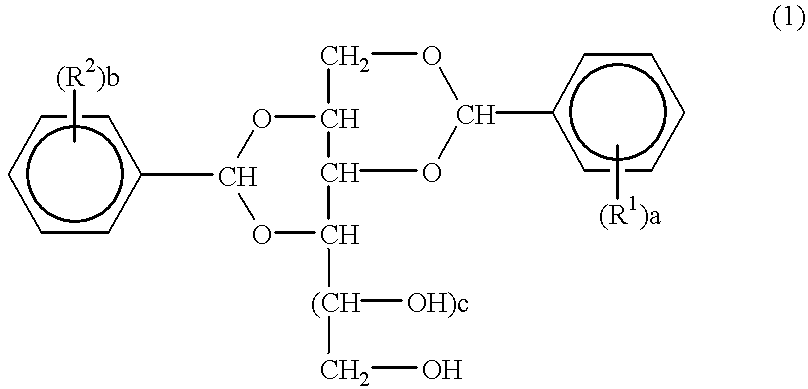Method for recrystallizing diacetal in polyolefin resin
a polyolefin resin and diacetal technology, applied in the field of recrystallizing diacetal in polyolefin resin, can solve the problems of deteriorating working environment, poor product quality, and inability to meet the needs of production,
- Summary
- Abstract
- Description
- Claims
- Application Information
AI Technical Summary
Problems solved by technology
Method used
Image
Examples
example 1
Using 0.25 wt. part of a nucleating agent composition [diacetal is 1,3:2,4-bis-O-(p-methylbenzylidene)-D-sorbitol (hereinafter abbreviated as "MD"); containing 1000 ppm of potassium p-methylbenzoate, 80 ppm of p-methylbenzaldehyde, and 0.2 wt. % of water], pellets and sheets were produced.
The degree of discoloration of the obtained pellets, the properties of the obtained sheets (haze, degree of discoloration and amount of generated aldehyde), diameter and proportion of the protofibrils, as well as the amount of the position isomers of diacetal in the above nucleating agent composition are shown in Table 1.
In Example 1 and other Examples and Comparative Examples and in Table 1, the alkali content, aldehyde content, water content, and the content of the position isomers of the diacetal are based on the nucleating agent composition.
The amount of generated aldehyde is based on the sheet.
The proportion of protofibrils in the recrystallized diacetal is the proportion (vol. %) of protofibr...
example 2
Using 0.25 wt. part of a nucleating agent composition [diacetal is 1,3:2,4-bis-O-(3,4-dimethylbenzylidene)-D-sorbitol (hereinafter abbreviated as "DMD"); containing 800 ppm of potassium 3,4-dimethylbenzoate, 100 ppm of 3,4-dimethylbenzaldehyde, and 0.2 wt. % of water], pellets and sheets were produced.
The discoloration degree of the obtained pellets, and the properties of the sheets (haze, degree of discoloration and amount of generated aldehyde), diameter and proportion of the protofibrils, as well as the amount of the position isomers of the diacetal in the nucleating agent composition are shown in Table 1.
example 3
Using 0.25 wt. part of a nucleating agent composition [diacetal is 1,3:2,4-bis-O-(2,4,5-trimethylbenzylidene)-D-sorbitol (hereinafter abbreviated as "TMD"); containing 200 ppm of potassium 3,4-dimethylbenzoate, 150 ppm of potassium hydroxide, 100 ppm of 2,4,5-trimethylbenzaldehyde, and 0.2 wt. % of water], pellets and sheets were produced.
The discoloration degree of the obtained pellets, and the properties of the sheets (haze, degree of discoloration and amount of generated aldehyde), diameter and proportion of the protofibrils, as well as the amount of the position isomers of the diacetal in the nucleating agent composition are shown in Table 1.
PUM
| Property | Measurement | Unit |
|---|---|---|
| Fraction | aaaaa | aaaaa |
| Fraction | aaaaa | aaaaa |
| Fraction | aaaaa | aaaaa |
Abstract
Description
Claims
Application Information
 Login to View More
Login to View More - R&D
- Intellectual Property
- Life Sciences
- Materials
- Tech Scout
- Unparalleled Data Quality
- Higher Quality Content
- 60% Fewer Hallucinations
Browse by: Latest US Patents, China's latest patents, Technical Efficacy Thesaurus, Application Domain, Technology Topic, Popular Technical Reports.
© 2025 PatSnap. All rights reserved.Legal|Privacy policy|Modern Slavery Act Transparency Statement|Sitemap|About US| Contact US: help@patsnap.com



